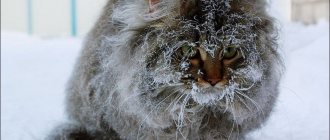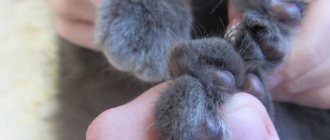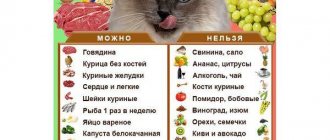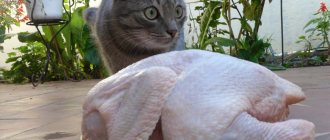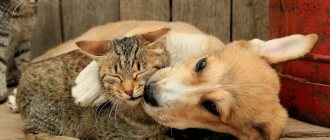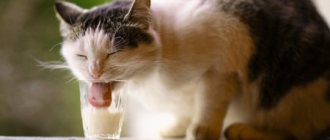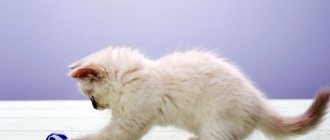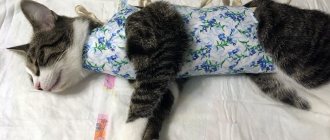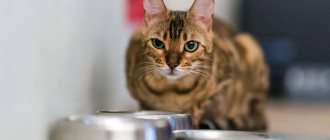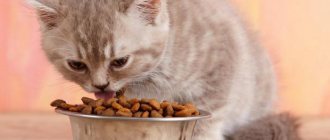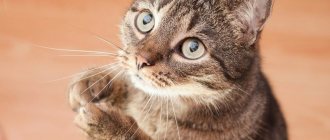Forecasters promise a sunny day, but there is a snowstorm outside. Inaccuracies in forecasts are associated both with rapidly changing environmental conditions and with global climate transformations. Nevertheless, modern meteorologists have made a breakthrough in forecasting; today, mathematical algorithms are used for this, and new methods and tools are being created to study current weather conditions.
How natural phenomena are studied today and whether it is possible to make perfectly accurate forecasts in the future was clearly discussed in the American popular science magazine Discover. T&P adapted the article and translated it.
Manifestation of the cat in the history of Ancient Egypt
Cats in Ancient Egypt were of two breeds: "Junk cat" or "African wild cat". They were the first domesticated pets to have their own owner. The process of taming the cat breed itself occurred gradually.
In those distant times, it was Egypt that was known throughout the world for its grain harvest. Small rodents often spoiled supplies, but it was noted that the cat of Ancient Egypt, as now, is an excellent mouse hunter. In addition, she often saved people from snakes, which she also deftly caught. So that the little predator continued to protect their home, people left them tasty, fresh fish. The cats gradually got used to this and became domesticated. This happened around 2000 BC.
Historically, it is known that during the New Kingdom, cats in Egypt were depicted on many objects, including even on the tombs of pharaohs or people of lesser fame. It often happened that these animals showed excellent hunting skills while hunting birds together with their owner or while fishing. There are many drawings where a cat sits next to the owner’s chair, personifying protection and friendship.
Something else interesting: Prophet Muhammad's cat
What made cats sacred in ancient Egypt?
Written by Jim Barnes
07.11.2018 16:17
Zoosphere » Interesting
It's no secret that cats were very important animals in Ancient Egypt. Archaeologists still find plenty of evidence of this in the form of figurines, paintings and jewelry depicting cats. In addition, during their lifetime, cats were hung with jewelry, gifts were brought to them, they lived in palaces and in general they were revered as gods. But what made them so important and untouchable?
One more interesting fact about cats before we move on to the explanations. If a cat living in the palace died, then mourning was declared in the country for 70 days. And even the pharaoh himself had to trim his eyebrows as a sign of reverence and respect for the keshka. Like this. And also, archaeologists have more than once found mummified cats. They were considered helpers in the other world. Now let's figure out why the ancient Egyptians loved cats so much, which made people worship cats and even build separate palaces.
Cats first appeared in Egypt around 2000 BC. The Egyptians especially liked their gracefulness and carefree nature. But first of all, they were grateful to cats for hunting snakes, rodents (especially rats, which carried the plague) and preserving wheat supplies.
The Egyptians loved cats so much that if someone accidentally killed a cat, they immediately dealt with him (more often than not, they also killed him). Killing a cat was a very terrible crime.
The simple love of the Egyptians for these pets resulted in the sacralization of cats. For the first time they were endowed with divine qualities. It even got to the point that everyone’s beloved and revered Ra was depicted as a red cat who eats a snake every day. And Bastet (the goddess of fertility, hearth and love) was often found in the form of a woman with the face of a cat. It was in her honor that many palaces were built and holidays were celebrated. And it was from the moment when Bastet began to be associated with a cat that they began to be turned into mummies.
More than once it happened that the ancient Egyptians could return to a burning house to make sure that there was no cat left there. Which once again shows how warmly cats were treated in Ancient Egypt. The apogee of the cat cult came during the New Kingdom. In honor of Bastet, the entire city of Bubastis was built.
Nevertheless, there was a brave soul who, by imperial decree, banned the cult of cats. This happened already in 390 AD. e. Reverence, love and interest began to slowly fade away. But only as deities and objects of sacralization. The simple love of cats seems to have remained with the Egyptians for a long time. And not only here, but all over the world.
Photo: kruto.online
The cat is one of the sacred animals of Ancient Egypt
The Egyptian cat-headed goddess Bastet is one of the most popular goddesses worshiped by the ancient Egyptians. She personified fertility (of women and the earth), life, and home. Before cats were considered pets, Bastet was depicted with the head of a lioness or in the image of this animal. After 2000 BC, images of Bastet changed - she was painted with a cat's head or in the form of a graceful cat.
Bastet herself had black cats. The cat was also associated with Pasht (Moon), which among the Egyptian goddesses was the dark side of Bastet. In this regard, it was believed that the cat was directly connected with the Moon.
The cult of the cat in Ancient Egypt had a prominent representative - the city of Bubastis, where there was a temple dedicated to the goddess Bast. The residence of Shoshenq I was also located in this city. It was here that festive events associated with the cult of worship of the goddess with a cat's head took place. Later, it was here that the largest burial of cat mummies was found.
Animal cult in ancient Egypt
sacred bull
The Egyptians revered bulls very much. Of all these horned animals, one was carefully selected, which was later considered a deity. The bull played the role of the sacred Apis and had to be black with white spots.
The divine bull lived in Memphis in a special stable for sacred animals located at the temple. The bull was given such excellent care that even the most successful people could not afford. The animal was fed to its fullest, protected, revered as a god, and even provided with a harem of cows. Each birthday of Apis was noisily celebrated and ended with the sacrifice of bulls to the deity. The funeral of Apis was also distinguished by its pomp, after which the Egyptians began to choose the next divine bull.
Hyena
Humanity did not immediately choose cats and dogs as pets. At first, ancient people tried to experiment with the domestication of rather unusual species. More than five thousand years ago, the Egyptians managed to domesticate hyenas and keep them as their pets. According to images preserved on the tombs of the pharaohs, the help of hyenas was used for hunting.
It is known that the Egyptians did not have much love for these animals, so they bred and fattened them exclusively for food. And even then until a certain time, until more “accommodating” dogs and cats competed with them.
Mongooses
The Egyptians had sincere feelings for mongooses. These brave furry animals were considered the most sacred animals. Legends were made about the courage that the Egyptian mongoose possessed in battle with giant cobras, and the ancient Egyptians even made statues of animals from bronze, hung amulets with images of animals around their necks and kept them at home.
Research has shown that some Egyptians were even buried with their pets, mummifying the remains of the animals. The mythology of Ancient Egypt is also replete with references to mongooses. It was believed that the sun god Ra could transform into a mongoose to fight against adversity.
However, after some time, mongooses fell out of favor with the Egyptians because these animals ate crocodiles' eggs.
Cult of the cat in ancient Egypt
Cats in Egypt were also considered divine creatures. For killing a cat, even if it was accidental, the punishment was death. No exceptions were allowed on this issue. There is information that even the Egyptian king once wanted to save the death of a Roman who accidentally killed a cat, but it didn’t work out. The Egyptians were not afraid of a possible war with Rome, lynching a man right on the street, where his corpse remained lying.
According to one legend, it was because of cats that the Egyptian people lost the war. Persian king Cambyses from 525 BC. was preparing to attack Egypt and ordered his troops to catch the cats and attach them to their shields. The Egyptians, noticing the frightened sacred animals, immediately surrendered to the enemies, since they had no right to risk the divine beasts.
The cat was tamed by the Egyptians and was considered a full member of the family. When a cat died, the Egyptians declared mourning in the family, during which everyone living in the house with the cat had to shave their eyebrows. The cat's corpse was embalmed, scented and buried in the grave along with mice, rats and milk, which would be useful to the animal in the afterlife. There were a huge number of cat burials in Ancient Egypt. In one of which, researchers discovered approximately 80 thousand embalmed animals.
Cheetahs
Despite the cult of cats, the Egyptians were not prohibited from hunting lions. And the cheetah at that time was considered by the Egyptian people to be a small and fairly safe cat, which was often kept in rich houses.
Ordinary residents, of course, could not afford to have a cheetah, but King Ramses II had a huge number of tame cheetahs in his palace, like many other representatives of the nobility. Sometimes the Egyptian kings domesticated huge, formidable lions, instilling fear even in our contemporaries.
sacred crocodile
The city of Crocodilopolis was considered the religious center of Egypt, dedicated to the deity Sobek, who was depicted as a man with a crocodile head. In this city there lived a sacred crocodile, people from all over Egypt came to see it. The crocodile was decorated with gold and precious stones, and a whole team of priests worked on its maintenance.
The crocodile was given food as a gift, which he immediately ate. The same priests helped open the crocodile's mouth, and they poured wine into his mouth. The dead crocodile was wrapped in thin cloth, mummified and buried with all honors.
Scarab beetle
Among the Egyptians, it was believed that scarab beetles were mystically born in excrement and endowed with magical powers. The Egyptian people noticed how scarabs rolled balls of excrement and hid them in their burrows. But people still could not understand that a female scarab lays eggs in each ball, from which the bugs appeared. Every Egyptian considered it their duty to wear a talisman in the form of a miraculous scarab, protecting them from evil, poison, and even granting resurrection after death.
The cult of scarabs originated from the sun god Khepri and was directly related to spontaneous generation.
Birds
Birds were also revered in Egypt. For accidentally killing an ibis, kite or falcon, the offender faced the death penalty. The god of wisdom Thoth, depicted with the head of an ibis, was respected by all the ancient Egyptians. It was he who was considered the creator of writing and literature. The corpses of ibises, which personified wisdom, grace and tact, were also embalmed.
The most revered bird was the falcon, identified with the god Horus. The falcon has always been considered a bird that patronizes and protects the pharaoh and his power.
Kites were a symbol of the sky, and the female white kite was the embodiment of the goddess Nekhmet, symbolizing power.
The unique life of cats in Ancient Egypt
The whole world knows that the cat, the sacred animal of Egypt, was not only revered, but everything was done to preserve its better life. There are many facts that the sacred cat of the temple had not only the best food, which was grown especially for her, but also a person who devoted his whole life only to caring for her - organizing her rest, musical accompaniment, space. In addition, this profession was inherited and was considered one of the most important.
If a cat in the house got sick, the owner went to the temple for a sacrifice, which included livestock or a large share of the family’s supplies. The priests took the gift and asked the gods to heal the pet.
Something else interesting: Signs and beliefs about cats
If the cat did die, then the whole family had to endure mourning, during which everyone prayed a lot, shaved their eyebrows and ate only very modest food. The funeral procession itself included mummification, after which the animal was placed in a coffin, decorated in accordance with the wealth of the animal's owner - the coffin itself was made of wood and decorated with gold, precious stones, carvings and various designs. For this reason, poor people did not keep a cat at home. Instead, they had figurines of this animal or the goddess Bast herself.
Killing a cat in Ancient Egypt was punishable by death or a very large fine. The severity of the punishment could be considered in accordance with the status of the pet's owner - if a person kills the ancient animal of a rich person, then one can receive a very severe punishment, up to and including the death penalty. In this case, the accident or premeditation of the murder did not matter.
How does weather occur?
The Earth's atmospheric layer consists mainly of nitrogen, oxygen and water vapor. This air behaves like a liquid and, flowing from one place to another, changes temperature, humidity and other characteristics. Weather is a byproduct of the atmosphere, which transfers heat from one place to another.
Cooler air is dense and cannot hold much moisture; warmer air is less dense and can hold more water. When areas of air with different temperatures and densities collide, rain occurs as water is formed from the cooled warm air. Other precipitation may occur. As warm, moist air rises, it cools and water condenses on particles suspended in the air. The rising drops become heavier and subsequently fall to the Earth.
A hurricane is formed when seawater heats above 27℃ and evaporates intensely, and the air over the ocean becomes warm and rises. In its place come currents of cold air, which also heat up and rise. These movements create strong winds and a hurricane is formed.
A modern take on the cat in Egypt
The cat of Egypt traveled from deity to squalor over several thousand years. Now these graceful animals are not so seriously revered. Many street cats have learned to live together even with dogs. In hotels you can find many cats roaming around freely. They are fed and cared for by local staff. At the same time, they are very affectionate and kind to every guest. Some streets are so filled with cats that it is impossible to step on them without hitting the graceful predator.
Many visitors to Egypt consider local cats to be too skinny and, at first glance, they seem to be abandoned. However, this is not quite true. The real Egyptian cat has a rather thin build, with long legs and a slightly elongated muzzle. Their fur is quite short. Such changes in the physique of many pets are associated with the climate of Egypt. But you can also find plenty of fluffy felines there, because the first cats were brought from Persia.
Goddess Bastet and her sacred black cats
The most significant cult in Ancient Egypt was the cult of the cat goddess Bastet, which lasted until 1 BC. e.
INTERESTING TO KNOW: Interesting information about cats and cats
It is believed that Bastet, the mother of cats, is the daughter of Osiris and Isis. This is the all-seeing goddess of fertility, sun, joy, fun. She was a guardian of the sun god Ra. The ancient Egyptians associated her name with sunlight and moonlight, the comfort of the family hearth, and material wealth. Egyptian women often prayed that she would send them a successful marriage and a successful birth.
Images of the deity have been preserved, where she appears as a maiden with the head of a cat or lioness. At the same time, the cat's head personified the good side, the lion's head the evil one.
The cat goddess was dressed in a green robe. In her right hand the goddess held a sistrum - a musical instrument, and in her left hand - a mirror (hathor). There were always four kittens at Bastet's feet.
The formidable essence of Bastet is called Pshat, which is often depicted with wings.
The religious center of the worship of the deity was located in the city of Bubastis, where, according to the works of the Greek historian Herodotus, at that time there was the most beautiful temple, whose priests served Bastet and bred sacred black cats. It is there that you can find a huge number of mummified animals.
In the center of the sacred place was a grand statue of the goddess. Every year, a commemoration of the divine cat took place in the temple, to which many people gathered; the celebration took place on a large scale, with great pomp. So, during the spring holidays, a huge statue was taken out of the sacred place and loaded onto a boat, after which it was transported along the banks of the Nile so that everyone could pay tribute to the deity.
The servants of the goddess Bastet belonged to a certain caste of priests, consisting of noble people holding high positions under the pharaoh. It was an honor to care for animals, and the right to do so was inherited - the son took it over from his father. If a priest treated cats with neglect or cruelty, he was severely punished.
The Egyptian Mau cat is a sacred animal of ancient Egypt. The priests carefully watched the divine animals, expecting that they would convey to them the sign sent by their patroness, so that they could then interpret it. The priests and noble people of Egypt gave themselves tattoos that depicted sacred cats.
